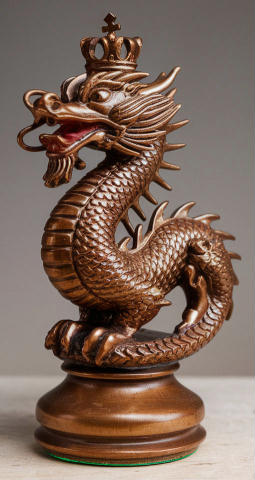Piececlopedia: Dragon King
Historical notes



In Shogi, the Japanese form of Chess, the Dragon King (龍王, transliterated as ryūō) is the promoted form of the Rook, moving like a Rook or a Ferz. This piece is also commonly used in many Shogi variants, such as Chu Shogi, in which it is a unpromoted piece that gets to promote to an even more powerful piece called a Soaring Eagle.
A Rook/Ferz compound is functionally identical to a Rook/King compound, and people have often thought of this piece as the latter, because the King is better known than the Ferz. With this in mind, it has sometimes been called a Crowned Rook, as in the 18th Century Chess variant The Duke of Rutland's Chess.
In Shatar, which is Mongolian Chess, is has been called a Berse or a Queen. In Man and Beast 01: Constitutional Characters, Charles Gilman called it a Chatelaine, meaning a lady of a stately home. In Sac Chess Kevin Pacey called it a Sailor. Jean-Louis Cazaux has called it an Admiral in several of his variants. In Very Heavy Chess, he says that he felt the name of Dragon King was inappropriate in the context of his variant, and he wanted a more elevated name than Sailor.
Despite having the word King in its name, the Dragon King is normally a non-royal piece. However, Fergus Duniho has used a royal version of the Dragon King in Fusion Chess and several more games based on it, such as Bedlam and Thunder Chess. In these games, it is one of four possible royal pieces, which a player can form by merging his King with a Rook.
Movement
The Dragon King may slide any number of spaces orthogonally, or it may step one space diagonally. Orthogonal movement follows along rows of spaces connected by common sides. On a regular board, this is horizontal and vertical, but on a hexagonal board, it is sometimes slanting. Spaces are diagonally adjacent when they are connected at a corner and share no sides in common. On a regular board, diagonally adjacent spaces share a common corner, but on a hexagonal board, they are connected only by an adjoining line.

|

|
For a more detailed explanation of a Dragon King's movement on a hexagonal board, read about Hex Shogi.
Graphics
The following images are used in different piece sets used on this site for Game Courier or Interactive Diagrams.
These feature both Kanji characters. The top one, 龍, means dragon, and the bottom one, 王, means king:




These feature just the Kanji character for dragon, in what is known as abbreviated Kanji. Most of these use the simplified (Shinjitai) version of the character, 竜, which looks more like a dragon.





These suggest a promoted rook by modifiying the image each set uses for the rook:



These images combine aspects of the king and rook images to suggest a royal dragon king:


These feature a movement diagram. The first one also idesignates the piece with the letters DK for Dragon King:


Printable Pieces
The following designs are available for printing on a 3D printer. Links are to Thingiverse.





This is an item in the Piececlopedia: an overview of different (fairy) chess pieces.
Originally written Sergey Sirotkin. Substantial revisions made by Fergus Duniho.
WWW page created: December 16, 2001. Last modified: December 17, 2001.
